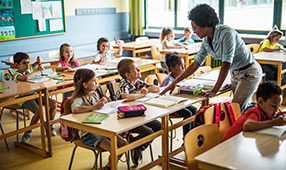Your students may be dealing with a range of crises, from distressing national news of natural disasters, terrorist threats and school shootings, to trauma that hits closer to home, such as abusive caregivers, family illness and suicide.
Experts agree childhood trauma is among the most relevant and significant psychological factors affecting education today. In one study of traumatized youth, 78% of the children studied reported multiple adversities, with the average initial exposure at 5 years, suggesting trauma typically occurs early and repeatedly. To add insult to injury, exposure to adverse events and trauma hampers student learning and their ability to develop the skills needed to thrive.
The good news: Educators are in a unique position to help students feel safe, supported and connected, says Ben S. Fernandez, M.S., Ed., Lead School Psychologist, Loudoun County Public Schools in Ashburn, Virginia. “In addition to teaching reading, writing and math, teachers are building meaningful relationships with students.” In some cases, schools offer the only reliable support a child has—and that makes a lifelong impact.
Not only can educators forge important relationships with students, they’re also in a good position to model effective coping skills. Here, five strategies to establish a supportive, compassionate environment that enhances social, emotional and academic well-being.
1. Plan ahead. Don’t wait for a crisis to strike to prepare a response. “Preparedness is critical,” says Fernandez. In addition to emergency drills, periodic policy reviews and educational activities surrounding crisis response, school assemblies can safeguard student well-being. To that end, Fernandez’s district in Loudoun regularly hosts depression and suicide awareness presentations. “We explain the symptoms of depression, what it looks like, and most importantly, what to do if you think a friend is considering suicide.” In at least one instance, these efforts saved a life. When a Loudoun teen didn’t show up for class, his friend told staff the absent child had warning signs of suicide. When authorities arrived at the boy’s house, he was in his room writing a suicide note.
2. Model effective coping strategies. Whether you’re teaching preschoolers or teenagers, children take their cues from adults. You’ll be better equipped to respond to students’ needs if you’re coping well yourself. To help you feel more connected and secure, discuss your feelings with family, friends and especially colleagues. “Go to happy hour with your colleagues or just sit in the classroom and have a conversation about what’s happened so you can process it yourself,” says Anne McInerney, LCSW, District Homeless Liaison at Project REACH/Fostering Connections, St. Paul Public Schools. Then strive to maintain healthy routines outside of the classroom. Eat well, exercise and avoid numbing your feelings with alcohol or other substances. Remember, too, that it’s okay to take a time out and/or ask for help.
3. Don’t sweep trauma under the carpet. Encourage children to talk about traumatic events that affect the whole school. Carve out class time to give children an opportunity to share their experiences in a safe, accepting environment. They don’t even have to communicate in words. Varying projects including drawing, storytelling, music and drama can help children bring life to their emotions around distressing events. Need help coming up with an appropriate icebreaker? Ask a school psychologist, social worker or counselor for ideas.
4. Call in supports. Before crisis strikes, determine who you can call in your district for support. “It’s important for staff to know who is available either in their building or in their district to help with difficult situations,” says McInerney. Social workers, school counselors, even support services that fall outside the school system may be relevant in some cases. If you’ve identified those resources, you’ll know exactly what to do and who to call when you see a child crying in the corner.
5. Watch for warning signs. Depending on the developmental age of the child affected, symptoms may include sleep disturbances, withdrawal from friends, clinginess, poor concentration, delinquent behavior, even physical complaints. “As educators, when you see certain behaviors, whether aggression or apathy, take a step back and ask yourself whether the child is really being oppositional and defiant, or if there’s something else behind those behaviors,” says Fernandez. Even frequent headaches or stomachaches could be signs of emotional distress.
While there isn’t anything inherently good about surviving a crisis or trauma, research suggests educators and students alike may experience significant growth on the heels of such struggles.
The key to ensuring students grow from traumatic experiences rather than shrink from them? Creating a safe, supportive environment that fosters a sense of optimism, extraversion and openness to new experiences.
RESOURCES
- National Educators Association’s Coalition to Support Grieving Students (GrievingStudents.org)
- American Academy of Child and Adolescent Psychiatry (aacap.org)
- American Red Cross (redcross.org)
- American School Counselors Association (schoolcounselor.org)
- American Psychological Association (apa.org)
- Federal Emergency Management Agency (fema.org)
- National Association of School Psychologists (nasponline.org)
- Suicide Hotline 1-800-273-TALK or 1-800-SUICIDE
- Crisis Text Line via the number 741741
Are you prepared for a school crisis? Learn more about preparing your classroom for an emergency.












